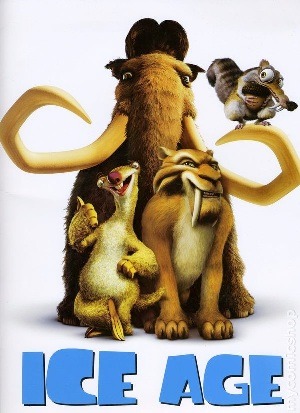
The Ice Age film franchise follows the adventures of three mammalian friends: Manny the woolly mammoth, Sid the giant ground sloth, and Diego the saber-toothed cat during the ice age. A passing knowledge of Earth’s history would inform the viewer that this is not meant to be an accurate representation of the real ice age that began over 2 million years ago. Normally, this could be seen as a criticism but to do so in this case would detract from the fact that these are animated, child-orientated films and to fault it for its lack of historical accuracy would be like calling a kid stupid for not knowing Mesozoic from Cenozoic.
Not wanting to find myself making children cry, I would default to my opinion that films are conduits for learning rather than to be taken verbatim as truth. If the Ice Age films made one child curious enough to look up mega fauna or geology then it’s done its job.
That said, as a learning experience for myself and as a road map to further understanding, I have taken it upon myself to break down different elements of the film and place them in their real geological and historical context.
Where are we?
The title gives away the fact that story take place during an ice age, more specifically the quaternary glaciation which began approximately 2.58 million years ago to this day, though we are currently in the inter-glacial period. While it may seem odd that we would consider our current era as an ice age, consider that during the cretaceous period global temperatures were on average 10 degrees Celsius warmer.
Some debate exists as to what kicked this off, whether it was orbital, atmospheric, geological, squirrel-rat induced; suffice to say that there was a lot of ice and it shaped the landscape through glaciers and other events.
Given that the ice began to retreat approximately 11 thousand years ago, we can hazard a guess that the Ice Age films take place between 2.5 million and 11 thousand years ago.
However, over the four films we are given conflicting information as to when during the quaternary glaciation the story takes place. Ice Age: The Meltdown (2006) seems to suggest that it was later in the ice age as things are well, melting. This would put it closer to the 11 thousand years ago mark.
But, with Ice Age: Continental Drift (2012), we get another geological milestone when Scrat appears to induce the separation of Pangea, the massive super continent that formed around 300 million years ago.
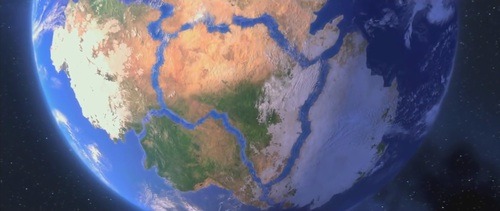
Pangea gradually separated and is regarded to have ceased existence as a super continent around 200 million years ago. If we were to assume that a saber-toothed squirrel accidentally caused the separation of Pangea then either Scrat can travel back in time or the film takes place over 200 million years before the current ice age.
But, Scrat may actually give us the most accurate way to date the story. In Ice Age (2002), Scrat is frozen in a block of ice and is set adrift. The film indicates that 20,000 years later he washes up onto a desert island. We cannot really use the coconut palm on the island to indicate a time period as fossil records show coconuts developed anywhere from 37 to 55 million years ago, but the climate does seem to indicate that it is closer to the climate we have today. So, that would date the story to around 20 thousand years ago, around 9 thousand years before the beginning of the Holocene period and the beginning of the inter-glacial period.
Fauna
Looking at the fauna in the films is a useful exercise to show both the range of animals that have existed and when some may have coexisted with one another.
The three main mammal species actually overlap in their existence and location. Megalonyx, giant ground sloths, existed between 10.3 million years ago to 11,000 years ago. Mammoths existed from around 5 million years ago to 4,500 years ago. Smilodons, saber-toothed cats, existed between 2.5 million years ago to 10,000 years ago. Additionally, all three animals also lived in present day North America, which is useful for the largely North American voice cast.
Humans, or at the very least the homo genus, existed in unison with the quaternary glaciation which would include the last 2.58 million years to today. So yes, humans did coexist with mammoths, sloths and smilodons (and may have in fact been partially responsible for their extinctions); though this factoids is fairly obvious when you look at cave paintings.
It is also interesting that Manny and Diego are appropriately proportioned but Sid is strangely tiny for his species. Giant ground sloths were very, very large, in some species almost twice the height of a human. Sid is comically shown to be smaller than adult humans, but I guess having him tower over everything would detract from his wacky antics.

Even within the context of the story, the film takes some liberties with where exactly they are within the ice age time scale. Manny the mammoth is under the impression he is one of the last of his species (he isn’t but there don’t seem to be many around), which would suggest they are closer to the end of their existence which would put it out of the range of his sloth and saber-toothed compatriots who died out around 5000 years earlier.
More confusingly, in Ice Age (2002) Sid is attacked by two brontops, real animals but they existed between 38 to 33.9 million years ago, missing the very existence of giant ground sloths by over 20 million years.
These issues are nothing when compared to the third instalment, Ice Age: Dawn of the Dinosaurs (2009) which suggests that mammals, humans and dinosaurs coexisted.
For the pedantic, technically this is true as the clade dinosauria extends to its evolutionary descendants which include present day birds. The more general term of dinosaur, however, tends to mean big reptiles with claws and teeth, you know, the ones we see in the movie Jurassic Park (1993) (itself a problematic title).
Dinosaurs and some small mammals did coexist, with the mammals that survived the Cretaceous-Paleogene extinction event going on to evolve into the mammals we have today, including us.
However, and I cannot stress this enough: dinosaurs did not coexist with humans and/or large mammals.
The central dinosaur in Dawn of the Dinosaurs is the tyrannosaurus which exited during the Cretaceous period, the last period to have large reptiles before the Cretaceous-Paleogene extinction event. While the film tries to depict the dinosaurs as having survived in a pocket of jungle, it doesn’t take away from the fact dinosaurs went extinct around 63 million years before the Ice Age story takes place. And this is troubling as they appeared to have survived without any new evolutionary adaptations, except maybe the development of cuteness. Then again, they are in an enclave and may have had no environmental pressures pushing for a need to adapt.
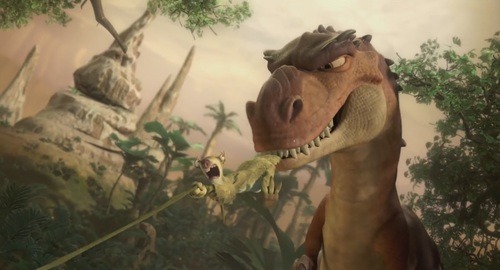
Furthermore, given that they did go extinct almost a literal era ago, it seems unusual that they would be describing their discovery as a dawn. “Dusk” may be dower for children but the sad reality is that all of these adorable creatures are now extinct. Suck it up kids.
Within this film itself we see numerous dinosaurs, but their coexistence is problematic as they all existed at different points of the Mesozoic era. For many people, the terms Triassic, Jurassic and Cretaceous are well known as periods within the Mesozoic era, the era when reptiles “ruled” the Earth.
It may be easy to lump all dinosaurs together as an amorphous group but the reality is that the Mesozoic era spans nearly 200 million years. So, with that in mind, here is a list of dinosaurs that appear in the film and when and where they existed.
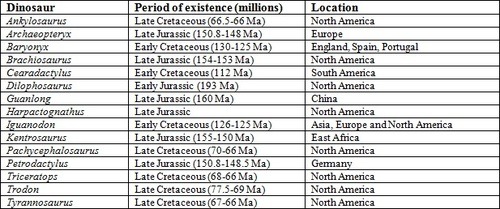
Essentially, these dinosaurs lived across a historical period of 127 million years, and while there is some overlap, they did not all live together, at the same time, in the same location. For example, Brachiosaurs died out 86 million years before Tyrannosaurs existed, and while a majority lived in what is now known as North America, many others lived in Asia and Europe.
Anthropology
Human artifacts appear throughout the series usually as cute jokes but a quick-fire number of shots during Scrat’s splitting of Pangea humorously suggests the origins of some of our most famous human-created monuments.

The Great Sphinx of Giza is the largest monolith statue in the world and was created by the Pharaoh Khafra between 2558-2532 BC, or around 4500 years ago. Humorously, as like the real Sphinx, Scrat-phinx loses its nose. A low-ball estimate of the Ice Age story taking place 11,000 years ago puts the Scrat-phinx about 5000 years before Ancient Egypt civilization, or just before most human civilization for that matter.
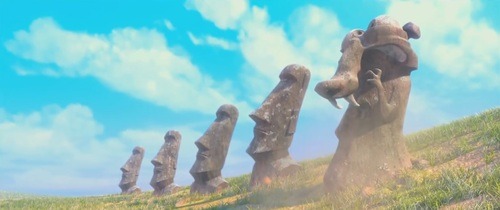
Moai, colloquially known as the “Easter Island heads” were created by the Rapa Nui people of Easter Island around 1250 to 1500 years ago. Aside from being way beyond the possible existence of any of the main characters in the Ice Age stories, the carvings are regarded as the last vestiges of this civilization before their collapse.

The Mount Rushmore National Memorial is a granite carving in the side of Mount Rushmore in Keystone National Park in South Dakota, United States of America. The sculpture was created by Gutzon Borglum and his son Lincoln Borglum between 1927 and 1941. The four presidents depicted, Scrat Washington, Scrat Jefferson, Scrat Rooservelt and Scrat Lincoln were actually meant to be depicted head to toe but lack of funding forced construction to cease early.
It goes without saying that since these sculptures were created within the lifetime of people alive today, so we cannot really expect to see mammoths during the last century.
Life imitating Art
Nonetheless, if there is something that can be learnt about art is that it can often be accidentally prescient. Scrat, the saber-toothed squirrel whose name is a portmanteau of squirrel and rat, is not a real animal but recent fossils have discovered an extinct species which has a passing resemblance to our acorn-phillic friend. Cronopio was named in 2011 and looks like a rat with large teeth.
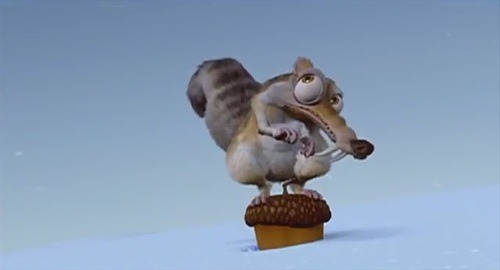
That said, it existed approximately 99.6 to 96 million years ago; right there with the dinosaurs but nowhere near the other mammals in the Ice Age films. Nor does it have a bushy tail, but instead a thin rat-like one. It also does not appear to be an ancestor to either rats or squirrels; instead it may be a precursor to modern day monotremes like koalas and kangaroos.
Yes, it would seem that Ice Age takes some considerable liberties with geological history. But at the same time its about a group of talking animals so lets not take it too seriously. Contrary to what it seems, this essay is less of a rebuke than it is an opportunity to learn about random bits of history.
